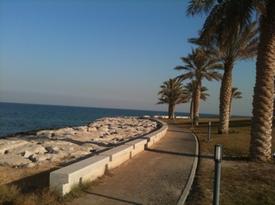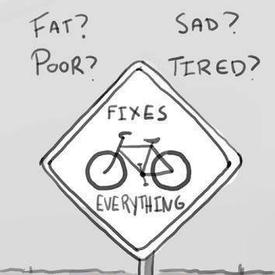Heart Rates while exercising
Options

ckapes
Posts: 31
I have been reading a lot of posts about the HRM, which I have one. A lot of you mentioned that your heart rates get up into the 180's when working out hard. I am trying to get back into running and when I am running my heart rate goes up to the 170's or higher depending on the distance, speed, hills, etc. I was always told that I should keep my rate in the high 130's - 140's so that I am burning fat not muscle. I was told that if I maintain a higher heart rate then is recommended I will be burning muscle. When my heart rate climbs to the higher numbers, I stop and walk and then I run again when my rate has stablized to the 130's. Is this the proper thing to do, or should I not worry and push myself to complete my run (approx 2 miles) and then cool down? I am 53 years old and am now down to 204 lbs. I have been back to exercising for approximtely one month.
0
Replies
-
Great question! I can't wait to see the responses.0
-
I want to say there is a chart that shows you where your heart rate should be for your age. But I will stand by and let someone more knowledgeable answer this. I just didn't want you thinking no one cared and was just reading
 0
0 -
I'm no expert, but I don't worry when my heart rate gets in the 170s because it means I am working out harder and burning more calories. I don't know about the whole muscle burning thing, but it doesn't sound right. I slow down when my body is telling me to and that's usually any higher than the 170s but that number could be different for each person. I say just listen to your body. When you are overexerting yourself, you're body will let you know and then you can slow it down a bit.0
-
http://whatscookingamerica.net/HealthBeauty/HighIntensityWorkout.htm
I hope this link will help alittle0 -
How to determine you Target Heart Rate Zone
MHR = maximum heart rate
bpm = beats per minute
30 year-old woman
40 year-old woman
50 year-old woman
60 year-old woman
Find your maximum heart rate (MHR) by subtracting your age from 220.
220 - 30 = 190 MHR
220 - 40 = 180 MHR
220 - 50 = 170 MHR
220 - 60 = 160 MHR
Next multiple (MHR) by 0.60 = lower end of the target heart rate zone.
190 x .60 - 114 bpm
180 x 0.60 = 108 bpm
170 x .60 = 102 bpm
160 x .60 = 96 bpm
Next multiply (MHR) by 0.90 = upper end of the target heart rate zone.
190 x .90 = 171 bpm
180 x 0.90 = 162 bpm
170 x .90 = 153 bpm
160 x .90 = 144 bpm
Target heart rate zone
114 to 171 bpm
108 to 162 bpm
102 to 153 bpm
96 to 144 bpm
The two numbers above represent the target heart rate zone. You should strive to stay between these two numbers during your workout.
Does this help (I pasted what I saw on link)0 -
0
-
It depends on a lot of factors: Age, weight, height, sex, fitness level, etc.
I'm 24, and now weigh 196 lbs (I started at 275 lbs a year ago). My max heart rate is 196, but the highest my HRM has ever recorded is 172, which felt very intense for me.0 -
From what I remember, you are correct, there is a range for pure fat loss. The main reason for the zones is where the energy is taken from. The 130 to 140 range pulls from fat stores only. I don't believe that the next range jumps directly to muscle though, since you have to be in those higher ranges to improve your running. There's a whole doctorate worth of places for our bodies to pull from. Too bad I can't afford the Doctorate eh?0
-
http://www.brianmac.co.uk/hrm1.htm
this has a great little calculator and explains it clearly (but not too long winded)
the higher %'s are still beneficial to your cardiovascular health and improved your overall fitness so don't be afraid to enter them too!0 -
Yes, thanks. I should be between 100 - 150, which is a little higher then I thought. Now I just need to know if it is unhealthy to stay above that 150 heart rate for any length of time. Thanks for everyones input.0
-
Heart rate training zones are calculated by taking into consideration your Maximum Heart Rate (MHR) and your Resting Heart Rate (RHR). Within each training zone, subtle physiological effects take place to enhance your fitness.
The Energy Efficient or Recovery Zone - 60% to 70%.
Training within this zone develops basic endurance and aerobic capacity. All easy recovery running should be completed at a maximum of 70%. Another advantage to running in this zone is that while you are happily fat burning you may lose weight and you will be allowing your muscles to re-energise with glycogen, which has been expended during those faster paced workouts.
The Aerobic Zone - 70% to 80%
Training in this zone will develop your cardiovascular system. The body's ability to transport oxygen to, and carbon dioxide away from, the working muscles can be developed and improved. As you become fitter and stronger from training in this zone it will be possible to run some of your long weekend runs at up to 75%, so getting the benefits of some fat burning and improved aerobic capacity.
The Anaerobic Zone - 80% to 90%
Training in this zone will develop your lactic acid system. In this zone, your individual anaerobic threshold (AT) is found - sometimes referred to the point of deflection (POD). During these heart rates, the amount of fat being utilised as the main source of energy is greatly reduced and glycogen stored in the muscle is predominantly used. One of the by-products of burning this glycogen is lactic acid. There is a point at which the body can no longer remove the lactic acid from the working muscles quickly enough. This is your anaerobic threshold (AT). Through the correct training, it is possible to delay the AT by being able to increase your ability to deal with the lactic acid for a longer period of time or by pushing the AT higher.
The Red Line Zone 90% to 100%
Training in this zone will only be possible for short periods. It effectively trains your fast twitch muscle fibres and helps to develop speed. This zone is reserved for interval running and only the very fit are able to train effectively within this zone.
Heart rate variations for a given intensity
A reduction in heart rate for a given intensity is usually due to an improvement in fitness but a number of other factors might explain why heart rates can vary for a given intensity:
Dehydration can increase the heart rate by up to 7.5%
Heat and humidity can increase the heart rate by 10 beats/minute
Altitude can increase the heart rate by 10 to 20%, even when acclimatised
Biological variation can mean the heart rate varies from day to day by 2 to 4 beats/minute
Resting Heart Rate
To determine your resting heart rate (RHR) is very easy. Find somewhere nice and quiet, lie down and relax. Position a watch or clock where you can clearly see it whilst lying down. After 20 minutes determine your resting pulse rate (beats/min). Use this value as your RHR.
If you have a heart rate monitor then put it on before you lie down. After the 20 minutes check the recordings and identify the lowest value achieved. Use this value as your RHR.
The heart is a muscle so with regular exercise it will become larger and become more efficient as a pump. As a result you will find your resting heart rate gets lower so you will need to check your RHR on a regular basis (e.g. Monthly).
Calculation of a zone value
The calculation of a zone value, X%, is performed in the following way:
Subtract your RHR from your MHR giving us your working heart rate (WHR)
Calculate the required X% on the WHR giving us "Z"
Add "Z" and your RHR together to give us the final value
Example:An athlete's MHR is 180 and their RHR is 60 - determine the 70% value
MHR - RHR = 180 - 60 = 120
70% of 120 = 84
84 + RHR = 84 + 60 = 144 bpm0 -
Good information, thanks!!

So.... my resting heart rate is 55. I'm 34 which would make my max heart rate be 186.
Using that math, I'm on the right track when my heart rate gets up to 160-170 when I'm lifting, and stays generally around 130-140 when I'm walking. Correct?
Now, does this also imply that working for a while at recovery level AFTER doing a lifting session would be a good thing?0 -
I was always told that I should keep my rate in the high 130's - 140's so that I am burning fat not muscle. I was told that if I maintain a higher heart rate then is recommended I will be burning muscle. When my heart rate climbs to the higher numbers, I stop and walk and then I run again when my rate has stablized to the 130's.
Who told you that you were burning muscle?
You're WORKING muscle, and building them, not burning it away!0 -
I got this off the walkingsite.com but it is the same thing my trainer told me the other day:
"TRAINING ZONES
Healthy Heart Zone (Warm up) --- 50 - 60% of maximum heart rate: The easiest zone and probably the best zone for people just starting a fitness program. It can also be used as a warm up for more serious walkers. This zone has been shown to help decrease body fat, blood pressure and cholesterol. It also decreases the risk of degenerative diseases and has a low risk of injury. 85% of calories burned in this zone are fats!
Fitness Zone (Fat Burning) --- 60 - 70% of maximum heart rate: This zone provides the same benefits as the healthy heart zone, but is more intense and burns more total calories. The percent of fat calories is still 85%.
Aerobic Zone (Endurance Training) --- 70 - 80% of maximum heart rate: The aerobic zone will improve your cardiovascular and respiratory system AND increase the size and strength of your heart. This is the preferred zone if you are training for an endurance event. More calories are burned with 50% from fat.
Anaerobic Zone (Performance Training) --- 80 - 90% of maximum heart rate: Benefits of this zone include an improved VO2 maximum (the highest amount of oxygen one can consume during exercise) and thus an improved cardiorespiratory system, and a higher lactate tolerance ability which means your endurance will improve and you'll be able to fight fatigue better. This is a high intensity zone burning more calories, 15 % from fat.
Red Line (Maximum Effort) --- 90 - 100% of maximum heart rate: Although this zone burns the highest number of calories, it is very intense. Most people can only stay in this zone for short periods. You should only train in this zone if you are in very good shape and have been cleared by a physician to do so."
My trainer said to try to be in these different zones in different workouts during the week - mix them up because each targets different goals. I also researched and found out that when your are not burning as many fat calories, you are burning carbohydrates. After burning carbohydrates your body must replenish and does that from fat stores. So even if you are not burning as much fat in the higher target zones, you eventually will lose fat due to the carbhydrates replenishing from the fat stores. I don't know if I have the lingo exactly right but hopefully you get the idea.
No where did I read that having your heart rate high during exercise burns muscle. It is not bad to train in those higher target zones. Each zone just has different benefits.
I am no expert on this but just what I have learned from a trainer and doing some research online.0 -
Ido same as you...I used to take my heart rate much higher but actually that can also be dangerous, ESP for me since I have exercise-induced urticaria too...anyhow, the fat burning happens in the range that you mention...safer and more successful for fat burning...just think most doctors recommend that walking is the best form of exercise....our heart rates don't go above 170 when we walk...0
-
There is no such thing as a 'fat burning" range. There is a lot of variability in heart rate response to exercise--I have gotten to the point where I don't even bother giving out target heart rates to clients--unless I work with them regularly and learn their specific HR response to different intensities.
The problem with all those elaborate "zone" descriptions is that Maximum Heart Rate can vary by 30 beats/minute among individuals who are the same age. Basically, 1 out of 3 people who use a heart rate chart will be working at a target heart rate that is significantly wrong for them. You always want to compare your heart rate with your feelings of perceived exertion and set up your own "scale".
The fuel you burn during exercise--whatever mix of carbs or fat--has no effect on stored body fat. Anyone who is actively trying to stay in a "fat burning" exercise zone is just sentencing themselves to an unbalanced and often less-effective workout program.
You should include a mix of intensities and durations in your cardio. Your fitness level will improve faster, allowing you to work harder and burn more total calories--and that's the most important thing.0 -
The problem with all those elaborate "zone" descriptions is that Maximum Heart Rate can vary by 30 beats/minute among individuals who are the same age. Basically, 1 out of 3 people who use a heart rate chart will be working at a target heart rate that is significantly wrong for them. You always want to compare your heart rate with your feelings of perceived exertion and set up your own "scale".
A nice problem to point out. Looking up your MHR off some chart somewhere does you no good whatsoever. You're not a chart, you're a person who's max/min HR can differ wildly from the rest of people out there, based on any number of variables. If you REALLY want to know your zones, you have to know your body, and there's no chart on earth that will tell you that. You gotta do that learning yourself.
Good luck figuring it all out! And, for what it's worth, I zone train all the time. I try to do a large amount of Z2 runs and rides, with occasional hill/speed drills where I get up into Z4, and occasionally (though not often) Z5.
Hope this helps.0 -
Why did your age only go to 60???0
This discussion has been closed.
Categories
- All Categories
- 1.4M Health, Wellness and Goals
- 396.7K Introduce Yourself
- 44.2K Getting Started
- 260.8K Health and Weight Loss
- 176.3K Food and Nutrition
- 47.6K Recipes
- 232.8K Fitness and Exercise
- 450 Sleep, Mindfulness and Overall Wellness
- 6.5K Goal: Maintaining Weight
- 8.7K Goal: Gaining Weight and Body Building
- 153.3K Motivation and Support
- 8.3K Challenges
- 1.3K Debate Club
- 96.5K Chit-Chat
- 2.6K Fun and Games
- 4.5K MyFitnessPal Information
- 16 News and Announcements
- 18 MyFitnessPal Academy
- 1.4K Feature Suggestions and Ideas
- 3.1K MyFitnessPal Tech Support Questions













